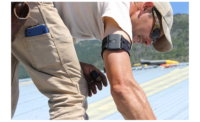The Mountain West is experiencing one of its hottest summers on record, and many employees work in occupations where they are exposed to hot, humid environments. In addition, some use special protective clothing and equipment that interfere with the body’s ability to dissipate heat and effectively maintain a normal body temperature.
Heat stress and heat-related illnesses can occur when the human body is exposed to hot temperatures for prolonged periods of time. When employees work in such environments, precautions should be taken to prevent heat-related illnesses. The concern is not merely for comfort. Working in hot environments can cause sickness and even death if precautions are not taken to prevent overheating.
Normally, the human body maintains a constant internal temperature by regulating blood circulation and sweat glands. When the body is exposed to hot temperatures, or warm temperatures with high humidity, several things happen. First, the body increases circulation of blood to the skin to be cooled, much like the fluid in a car radiator. Then, the sweat glands begin to produce more sweat to cool the skin by evaporation.
If the air temperature near the skin is the same or warmer than normal core body temperature, the body is not able to cool itself effectively. If there is no air movement near the skin, or if the air is humid, sweating will continue, depleting the body of fluids and electrolytes, and the core body temperature will begin to rise higher than normal. When this occurs, it can be life threatening. It is important to recognize the hazards of working in hot environments and the signs and symptoms of heat-related illnesses.
Heat Stroke
The most deadly heat-related illness is heat stroke. It occurs when the body has exhausted its ability to cool itself through sweating and circulation. The temperature regulatory system fails and sweating stops. This may occur with little warning to the employee and leave him or her unaware that a crisis stage has been reached. When heat stroke occurs, the employee’s skin is hot, usually dry, red or spotted.
Body temperature will be around 105 degrees Fahrenheit or higher, and the person can be mentally confused, delirious, convulsing or unconscious. Unless the employee receives rapid and appropriate treatment, brain damage and/or death can occur.
If signs or symptoms of heat stroke exist, call emergency medical services immediately and administer first aid. Move the employee to a cool area, thoroughly soak his/her clothing with water, and vigorously fan his/her body to increase cooling. Obtain further treatment at a medical facility to ensure recovery. Remember, heat stroke can be life threatening.
Heat Exhaustion
Heat exhaustion is less serious than heat stroke but may lead to heat stroke if not treated immediately. Heat exhaustion is caused by the loss of large amounts of fluid by sweating, sometimes causing excessive loss of salt and electrolytes. An employee suffering from heat exhaustion still sweats but experiences extreme weakness or fatigue, giddiness, nausea or headache. The skin is clammy and moist and complexion is pale or flushed.
Body temperature is normal or only slightly elevated. In more serious cases, the employee may vomit or lose consciousness. An employee with heat exhaustion should rest in a cool place and drink plenty of liquids. With this treatment, those with mild cases usually recover spontaneously. Those with severe cases may require medical care by a physician.
Heat Cramps
Heat cramps are painful spasms of the muscles that occur when a person sweats profusely in a hot environment, tries to replace body fluids by drinking water but does not replace salt loss. Drinking large quantities of water tends to dilute the body’s fluids, and the low salt level in the muscles causes painful cramps.
All muscles may be affected but usually the muscles performing work are most susceptible to cramps. Drinking salted liquids may relieve heat cramps. Heat Rash Heat rash, also known as prickly heat, occurs when sweat is not easily removed from the surface of the skin by evaporation, and the skin remains wet most of the time. The sweat ducts become plugged, and a skin rash develops. The rash may spread or be complicated by infection. To prevent heat rash, rest in a cool place periodically throughout the day and bathe and dry skin regularly.
Other Heat-Related Concerns In addition to the heat-related conditions mentioned above, some employees may experience fainting. This can occur when an employee who is not accustomed to hot environments stands erect and immobile for long periods of time. The blood vessels in the skin and lower parts of the body enlarge to regulate the body’s temperature, and blood may pool rather than returning to the heart to be pumped to the brain.




Post a comment to this article
Report Abusive Comment